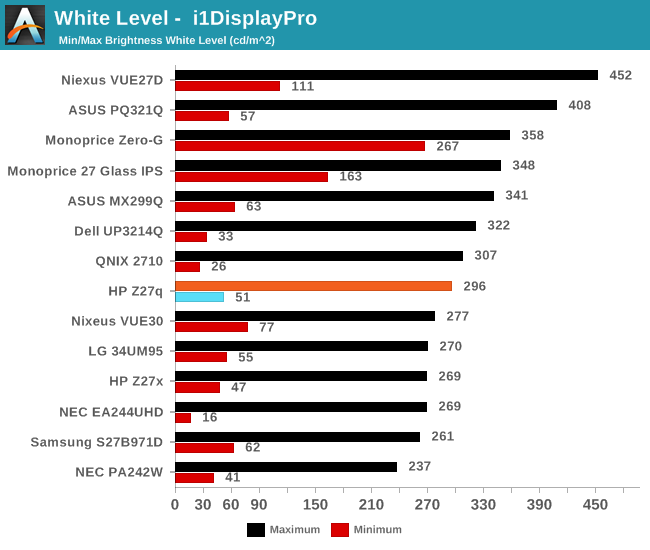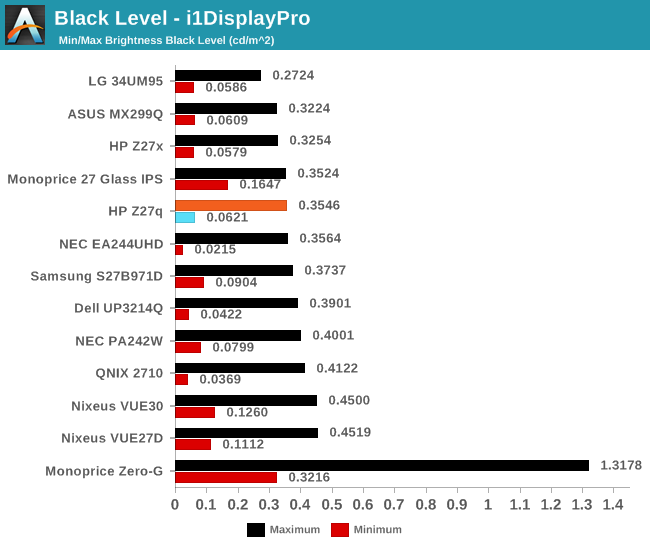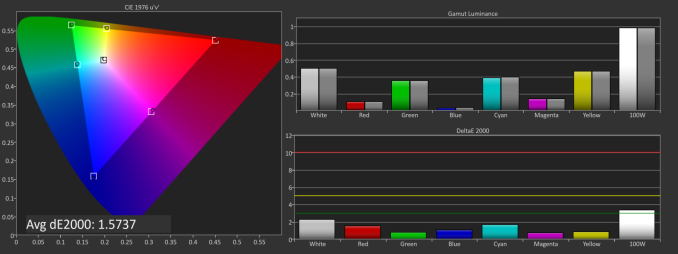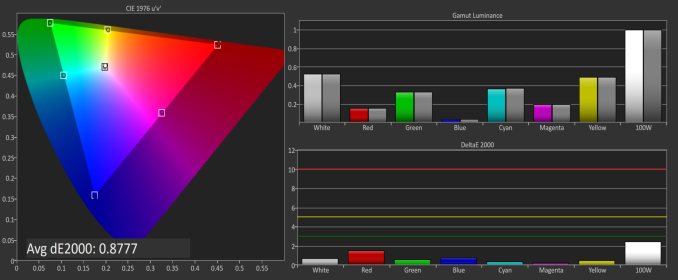HP Z27q Monitor Review: Aiming For More Pixels
by Brett Howse on December 22, 2015 8:00 AM ESTContrast and Brightness
Monitors for desktops don’t need the very high brightness of a tablet or smartphone, since they are used indoors. HP rates the Z27q as a 300 cd/m2 display, and I was able to hit almost exactly that at 296 cd/m2 which is plenty for indoor use. Minimum brightness was 50 cd/m2 so there is quite a bit of dynamic range there to find a suitable brightness for pretty much any office space.

Black levels are pretty consistent with IPS desktop panels, but overall they are a bit too high. Techniques like photo-aligning the backlight and panel can bring some big gains in black levels, but HP is not using such a panel. As such, the overall black levels are less than amazing. Contrast is ultimately not as important as proper gamma for this type of display, but still it would be nice to see better in expensive desktop panels at this point since the technology is available.

This gives us a pretty paltry contrast ratio of 833:1, which is a long way from the 1800:1 seen in some tablets and notebooks. HP is clearly ok with this performance though since it matches the Z27x almost exactly.

Ultimately even though this is a low price for a 5K monitor, it is still far from inexpensive. This is targeted more towards professionals who are after a better overall gamma curve and color accuracy, and consumers may want to stick to a more traditional panel with better contrast for things like watching movies.
Gamut Options
HP offers the very high gamut Z27x display, but the Z27q trades off that gamut for a higher resolution. Still, it can cover both sRGB and AdobeRGB (as well as Rec. 709) and there are built in options for picking the color gamut. The Z27q has a 14-bit LUT, but it is not user accessible, and is calibrated at the factory. Once dialed in, there is no way to adjust it after the fact, so people who are after the utmost in accuracy will likely have to spend a bit more.
Below you can see the gamut options for the Z27q. The additional gamut of AdobeRGB is easily achieved by this panel.
The built in calibration is quite impressive, with the Z27q nicely matching both the sRGB and AdobeRGB spaces with no issues. Some additional options would be nice though, especially DCI/P3, if only because the gamut is likely covered by this display anyway, but there is no way to set the panel to that range.












92 Comments
View All Comments
SanX - Monday, December 28, 2015 - link
I am surprized that you have started arguing having no slightestclue in the main basic thing of monitors. It is not the screen 103PPI what
matters but perceived PPI based on resolved angular dimensions of the pixels.
This and other factors also define optimal viewing distance.
The optimal distances are set by the TXH and SMPTE standards
and not the length of your legs. For 4K monitors perceived PPI are
almost whopping 600 and head turning 717 respectively. This makes 43"
TV too small for normal PC use and you have to put it closer to your
nose to utilize this excessive PPI. That in turn what causes discomfort,
and that is why you need larger size TV. Where Anandtech finds such
technodumbos like you? If you will start scaling PPI to be able see
the small fonts clearly that means trashing all 100% of spent money
on your "arguably better quality IPS panel" because those small scaled
fonts look uglier then on even 1080 one.
And yea, go and tell your mom that that you feel +5ms when there always
exists the intrinsic 100ms lag in human reaction. It's not the difference
between 21ms and 26ms which is 20-25% but the difference between
100+26ms vs 100+21ms or less then 4%, you genius. ROTFLMAO.
Tell also mommy that 44 ms is unacceptable for the static content
of the screens like text editing and browsing.
AnnonymousCoward - Tuesday, December 29, 2015 - link
> This makes 43" TV too small for normal PC useHilarious. Who could possibly take you seriously?
> this excessive [103] PPI
Again, huh?
> the intrinsic 100ms lag in human reaction
You're confusing reaction time with feedback lag. I score 240ms in online reaction tests but can sense 30ms of feedback lag. Reaction time includes the time to process stimulus and physically move something. Feedback is a different thing, since you're measuring the lag from what you already moved.
There are many thousands of others on the web who agree with what I'm saying. Take a look at the highly respected TFT Central: http://tinyurl.com/ngweqd9 They classify more than 32ms as "some noticeable lag in daily usage"! Whaduya know! 44ms is even off their chart.
Convinced yet? There's nothing wrong with being mistaken and learning, but staying in stubborn ignorance is foolish.
SanX - Tuesday, December 29, 2015 - link
Comprehension problems? Funny, no single my point was gotten. How i know that? I intentionally made a mistake in my numbers and you did not catch that ROTFL. What i said about DPI and lags, can repeat with your own words?This is 4th repeat that 44ms is for static contents use in PC mode. You will not notice the lag there, lag is noticeable if you move mouse fast. For fast games the Game mode exists with 20ms display lag in JU7500 and 26ms in JU7100, see Rtings "PC Monitor" and DisplayLag 2015 database which rate these monitors as excellent or very good. BTW, LG has even larger lag 55ms and i know people who still use it even in games. This is due to another point you did not get while - this is truly hilarious - trying to teach me what is what: in games the human reaction lag is more important than display lag and is always present. Think again about this if you actually can
AnnonymousCoward - Tuesday, December 29, 2015 - link
I destroyed pretty much all your claims, and yet you stay in ignorance and say things like "go tell mommy".SanX - Wednesday, December 30, 2015 - link
ROTFL. You can not even repeat in your own words what I said, "destroyer". And yea i'd suggest your mommy to take your Gameboy off.Guspaz - Monday, December 28, 2015 - link
You guys should take a look at the Asus PG279Q. 27", 1440p, IPS panel, 165Hz, G-Sync. I don't think I've seen any detailed reviews of it (the kind that actually benchmark it), although LinusTechTips did measure input lag at 12.5ms, which isn't bad.SanX - Tuesday, December 29, 2015 - link
Minor typos:THX 492
SMPTE 597
sharath.naik - Wednesday, December 30, 2015 - link
To have a usable 5k monitor. Below is the spec that would have the same PPI as a 4k 27 inch monitor.Display size: 36 inch
Screen curved.
Given this is still the minimum size for 5k you will still be sitting very close to the monitor, a flat panel will make it very hard to view the edges. So a curved screen is a must. This is for any manufacturers if they are reading this.
If not the above may be 2 27inch 4k monitors make more sense and is going to be cheaper too, and more convenient in terms of connectivity.
AnnonymousCoward - Wednesday, December 30, 2015 - link
Sorry to say, but your "spec" of 5K 36" curved won't be of any use to any manufacturer. They don't choose resolution and size based on what 1 random dude on the internet posted.